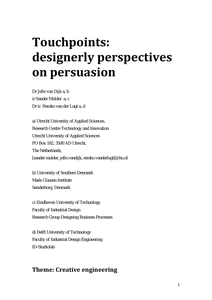Ambient Intelligent environments are interactive environments that sense human behaviour and can respond intelligently. This workshop explores how interactive environments can be designed with persuasive quality, influencing human experience and behaviour. The workshop follows a research-through-design approach where practise-relevant insights are gained while designing. The focus will be on intuitive and rational decision-making, the role of aesthetics in persuasion, social and spatial influences on persuasion and the ethics of designing for persuasion.
DOCUMENT

Our approach builds on both the design traditions of participatory design and embodiment. We attempt to connect these traditions to the existing body of knowledge on persuasion. First we describe some basic theoretical concepts and infer how they influence persuasive design. Then we present a basic framework with which we intend to address the different abstraction layers involved. Finally, we discuss the principal differences and meeting areas between the disciplines of design and communication, ending up with some considerations for a persuasion toolbox that is intended to help communication professionals and designers effectively design behavior change interventions that fit the messy lives of people in the real world
DOCUMENT

Social media, such as Facebook, offer brands the opportunity to reach their target audience in a less obtrusive way than traditional media, through sponsored posts. Regulations require marketers to explicitly inform consumers about the commercial nature of these posts. This study addresses the effects of sponsorship disclosures by means of a 2 (no disclosure vs. the sponsorship disclosure ‘Sponsored’) × 2 (source: celebrity endorser vs. brand) experiment. Results suggest that a sponsorship disclosure only influences the use of persuasion knowledge when the post is disseminated by a celebrity. Moreover, a disclosure starts a process in which the recognition of advertising (i.e., the activation of conceptual persuasion knowledge) causes consumers to develop distrusting beliefs about the post (i.e., higher attitudinal persuasion knowledge), and in turn, decreases their intention to engage in electronic word of mouth.
LINK